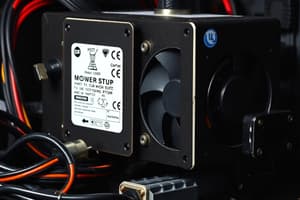Podcast
Questions and Answers
What is one practice to maximize energy efficiency when turning on a computer?
What is one practice to maximize energy efficiency when turning on a computer?
- Leaving all devices in standby mode
- Using low-quality cables
- Plugging into a power management strip (correct)
- Keeping printers and scanners on when not in use
What is the recommended command to initiate an immediate shutdown on a Windows computer?
What is the recommended command to initiate an immediate shutdown on a Windows computer?
- `shutdown -r -t 0`
- `shutdown -s -t 0` (correct)
- `restart -s`
- `restart -t 0`
Why is it important to close all open applications before shutting down a computer?
Why is it important to close all open applications before shutting down a computer?
- To increase power consumption efficiency
- To make the computer turn on faster next time
- To prevent unsaved data from getting corrupted (correct)
- To automatically update the computer's registry
How can hibernation mode affect a computer compared to a complete shutdown?
How can hibernation mode affect a computer compared to a complete shutdown?
What is a drawback of keeping devices like printers and scanners in standby mode when not in use?
What is a drawback of keeping devices like printers and scanners in standby mode when not in use?
Which action can help resolve software conflicts, ensure updates are installed, and clear temporary files?
Which action can help resolve software conflicts, ensure updates are installed, and clear temporary files?
Which type of cables enable energy-saving functions like standby mode on monitors?
Which type of cables enable energy-saving functions like standby mode on monitors?
How can using a wireless mouse impact power consumption in a computer?
How can using a wireless mouse impact power consumption in a computer?
What is a benefit of using a smart strip when turning on a computer?
What is a benefit of using a smart strip when turning on a computer?
What role does reducing pointer speed play in managing power consumption when using a mouse?
What role does reducing pointer speed play in managing power consumption when using a mouse?
Flashcards are hidden until you start studying
Study Notes
Managing Computer Power Efficiently
With the rise of modern technology and the growing concern for environmental sustainability, managing a computer's power consumption has become increasingly important. This article will explore the basic principles and techniques of power management as they relate to turning on, shutting down, restarting, and using a computer's mouse.
Turning On a Computer
When turning on a computer, consider the following practices to maximize energy efficiency:
- Plug into a power management strip: A power management strip, also known as a smart strip, can control power to peripherals and monitors, turning them off when the computer is not in use.
- Use proper cables: Opt for high-quality cables that enable energy-saving functions, such as standby mode on monitors and power-saving modes on USB devices.
- Avoid standby mode: Many devices, like printers and scanners, have standby modes that consume power even when not actively in use. Turn them off or unplug them when not needed.
Shutting Down a Computer
Shutting down a computer conserves energy and protects your hardware by allowing it to perform necessary tasks and update its registry before turning off completely.
- Close applications: Close all open applications before shutting down the computer to prevent any unsaved data from becoming corrupted.
- Use the shutdown command: Access the shutdown menu or use the command
shutdown -s -t 0in the command prompt to initiate an immediate shutdown. - Avoid hibernation: Hibernation mode, while conserving energy, may not be as efficient as a complete shutdown, especially if the computer is left unattended for extended periods.
Restarting a Computer
Restarting a computer can help resolve software conflicts, ensure updates are installed, and clear temporary files.
- Use the restart command: Access the restart menu or use the command
shutdown -r -t 0in the command prompt to initiate an immediate restart. - Clear temporary files: Before restarting, consider clearing temporary files and removing unnecessary software to reduce the startup time and free up storage space.
Using the Mouse
Mouse usage can indirectly affect power consumption through the computer's energy requirements, such as the CPU and GPU working to process the mouse's inputs.
- Opt for a wireless mouse: Wireless mice can reduce power consumption since they do not require a constant power supply through a cable.
- Reduce pointer speed: A slower pointer speed can reduce the frequency of mouse movements, which can indirectly reduce power consumption.
Additional Tips
- Use power management settings: The Windows power settings, for example, can help manage energy use by adjusting screen timeout, sleep mode, and power plans.
- Monitor energy use: Check the computer's power usage through the operating system or dedicated software to identify areas for improvement and track the effectiveness of power management efforts.
- Upgrade hardware: Invest in more energy-efficient hardware, such as processors, memory, and power supplies, to reduce overall power consumption.
Conclusion
By employing these power management strategies and techniques, computer users can significantly reduce energy consumption, prolong the lifetime of their hardware, and contribute to a more sustainable environment. As technology continues to evolve, so too will the tools and strategies available to help manage computer power efficiently.
Studying That Suits You
Use AI to generate personalized quizzes and flashcards to suit your learning preferences.




